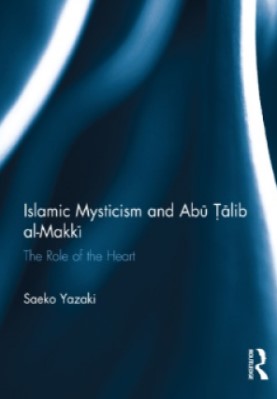Islamic Mysticism and Abu Talib al-Makki: The Role of the Heart

| Islamic Mysticism And Abu Talib Al Makki |
| Saeko Yazaki |
| 217 |
| |
| PDF Direct Download Link |
| Click for Hard Copy from Amazon |
ISLAMIC MYSTICISM AND ABU TALIB AL-MAKKI – Book Sample
Introduction – ISLAMIC MYSTICISM AND ABU TALIB AL-MAKKI
Despite the discourse on Islamophobia and topical issues around Islam and the West, Sufism appears to be accepted in Western society compared to other dimensions of Islam. Sufi thought is often described as ‘moderate’ and ‘tolerant’, in stark contrast, for example, to ‘extreme’ Salafis who attack ‘peace-loving’ Sufis.1
In addition to this liberal image, the religious status of Sufism in Islam seems to be equivalent to Yoga in Hinduism and Zen in Buddhism, especially in popular culture; while Islamic (or Hindu or Buddhist) aspects are not entirely neglected, they are not central.
The spiritual teachings of Sufism (and Yoga and Zen) are often regarded in the West as an alternative to conventional religious institutions and not incompatible with other belief systems.
Many Sufism-related organizations in Europe and the United States have contributed to this image by focusing on humanity, peace, love and the universality of mysticism.2 (One of the prime examples would be the doctrine of Inayat Khan (d. 1927) – the Sufi and musician from India who tried to spread the idea of universal Sufism in the UK, Holland, France and the USA.3)
Alongside this appreciation of Sufism that appeals to the popular spiritual movement, Islamic mysticism has also attracted significant scholarly attention in the West. The modern study of Sufism began in the colonial period when the image of Sufis was influenced partially by political interests and partially by European travellers’ narratives of exotic dervishes in the Orient.4
century, a number of scholarly works have been produced in Islamic studies in
various European languages. The topics range from general surveys of the doctrine of Sufism and translation of Sufi writings, to more specific studies of a certain figure, order or period in the history of Islamic mysticism.5
This book seeks to contribute to this growing body of literature, focusing on the tenth-century Muslim writer on piety, Abū Ṭālib al-Makkī (d. 386/996), whose major work Qūt al-qulūb (‘The Nourishment of Hearts’) appeared in different fields of study, including Sufism, asceticism, Ḥadīth, social sciences, Ḥanbalism and, beyond Islam, Jewish spirituality.
The Qūt was written in a period which is generally accepted as a time of systematisation of the Sufi tradition (the fourth/tenth and fifth/eleventh centuries). These two centuries produced various treatises which became important mystical guidebooks for later Sufis, and al-Makkī is often regarded as one of the earliest writers to have composed a ‘Sufi manual’.6
In the Qūt, al-Makkī discussed the role of the heart as the mediator between this world and the hereafter, governing human mind and body as king. He urged the reader to maximise the quality of the heart in order to be a pious believer carrying out God’s will.
The Qūt has been read widely as a guide on ethics and exerted a great influence on later Muslim scholars. For instance, the famous Islamic thinker Abū Ḥāmid al-Ghazālī (d. 505/1111) lists the Qūt first as a work on Sufism which he read for his study,7 and his heavy reliance on the Qūt in the writing of his magnum opus, Iḥyāʾʿulūm al-dīn (‘The Revivification of the Religious Sciences’), has been discussed by a number of scholars on Sufism.
Among prominent medieval Sufi authors, al-Makkī is highly esteemed, for instance, in the writings of al-Suhrawardī (d. 632/1234), Ibn al-ʿArabī (d. 638/1240) and Rūmī (d. 672/1273), where al-Makkī is praised as the author of a significant book on Islamic devotion, the Qūt. Compared to the straightforward respect al-Makkī enjoys from Sufi thinkers, Ḥanbalī literature reveals a more complex estimation in the writings of, for instance, Ibn al-Jawzī (d. 597/1200) and Ibn Taymiyya (d. 728/1328), which demonstrate a more ambivalent attitude towards al-Makkī and his thought.
The teachings of the Qūt may even have crossed faith borders, as some scholars in Jewish studies have pointed out al-Makkī’s influence on the Andalusian Jewish thinker Ibn Bāqūdā (d. after 1080), who composed a moral guidebook, al-Hidāya ilā farāʾiḍ al-qulūb (‘The Right Guidance to the Religious Duties of Hearts’), in Judaeo-Arabic.
The name of al-Makkī thus frequently appears in medieval literature in biographical dictionaries, Ḥadīth, Sufi and Ḥanbalī writing, and his relevance to scholarship lies beyond the study of Sufism, and even Islamic studies.
Despite this, few studies have carried out a critical analysis of al-Makkī and his work, and no single monograph has yet been published on the subject.
In 1992–5,…
To read more about the Islamic Mysticism And Abu Talib Al Makki book Click the download button below to get it for free
Report broken link
Support this Website
for websites